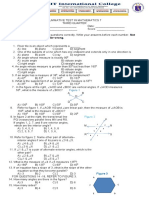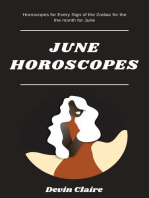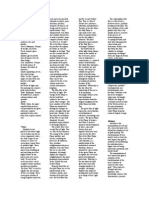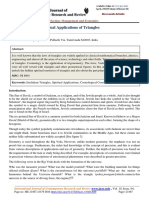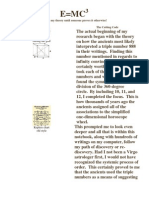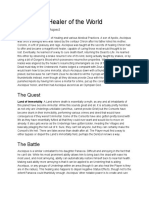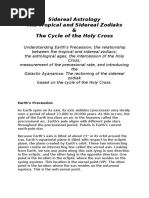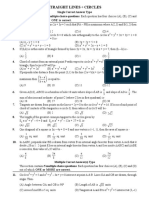The Geometry of Stars
The Geometry of Stars
Uploaded by
tofique_fatehiCopyright:
Available Formats
The Geometry of Stars
The Geometry of Stars
Uploaded by
tofique_fatehiCopyright
Available Formats
Share this document
Did you find this document useful?
Is this content inappropriate?
Copyright:
Available Formats
The Geometry of Stars
The Geometry of Stars
Uploaded by
tofique_fatehiCopyright:
Available Formats
THE GEOMETRY OF STARS
May 10, 2013 Tofique Fatehi tofiquef@yahoo.com http://tofique.fatehi.us
PRELUDE
Why ask for the moon, when we have the stars? - Tony Brent
Acknowledgment This is to acknowledge with thanks the meticulous effort put in by Parul Vijay Patil in the preparation of all the drawings for this essay.
In this essay I try to categorize star-shaped Figures, so that they can be systematically classified and documented. Not much work seems to have been done in this field, and so, I take full liberty to venture into it, using my own descriptions and evolving my own terminology, where none are clearly available.
STARS
Just as a plane figure of n sides is called a polygon, we may term a plane n-pointed star a polygram. This term is not in general use, and may even have a completely different meaning in some other branch of science. Depending on the value of n, many of these figures have specific names. Polygons are named pentagon, hexagon and so on, and polygrams are named pentagram, hexagram and so on. These figures are said to be regular if all sides and all corresponding angles are equal.
The Geometry of Stars 2013 Tofique Fatehi
Page 1
Figure 1a shows a regular hexagon (a six-sided polygon). If all the sides of the hexagon are extended on both sides, it produces a six-pointed star (as in Figure 1b). This star is called a hexagram.
Figure 1a - Hexagon
Figure 1b - Hexagram
Figure 2a shows a regular pentagon (a five-sided polygon). This produces a five-pointed star if all the sides are extended on both sides (as in Figure 2b). This star is called a pentagram. It is also sometimes called a pentalpha or a pentangle.
Figure 2a Pentagon
Figure 2b - Pentagram
The Geometry of Stars 2013 Tofique Fatehi
Page 2
The pentagram can be drawn fully, without lifting the pen from the paper (unicursally), and without breaking any side. The hexagram cannot be so drawn - at least not without breaking any side. In fact, the hexagram actually is composed of two interlaced equilateral triangles. Stars which can be drawn unicursally may be termed prime. Stars which are composed of interlaced figures may be termed composite.
It may be pointed out that there does exist a unicursal hexagram (much used in witchcraft), but then, that does not belong to any class of our present study. Just for the record, this is shown in Figure 3.
Figure 3
Figure 4 shows a square and a triangle (four-sided and three-sided polygons). For these figures, even if the sides are extended indefinitely, no star is produced. It may therefore be concluded that the minimum number of points required to form a star is five.
Figure 4a Square
Figure 4b Triangle
Now let's take a look at a regular septagon (a seven-sided polygon). This is also called a heptagon. This is shown in Figure 5a. As before, extending all the sides both ways produces a seven-pointed The Geometry of Stars 2013 Tofique Fatehi
Page 3
star, called a septagram or heptagram, shown in Figure 5b. It does not end here. If the sides are extended still further, another seven-pointed star is produced (as in Figure 5c). This also has the same name: septagram (or heptagram).
Figure 5a - Septagon
Figure 5b -Septagram of the First Order
Figure 5c -Septagram of the Second Order So now, we have two different seven-pointed stars, both regular, and both prime, and yet both different. We need to differentiate between these two forms. We do so by inventing an order. We shall call the first star (in Figure 5b) a septagram of the first order, and the second star (in Figure 5c) a septagram of the second order. It may be stated that there is no second order pentagram or hexagram. It is worth noting that any polygon can be considered a zero-order polygram. The Geometry of Stars 2013 Tofique Fatehi
Page 4
An unspecified order of any star may be designated as m. At this point, we may introduce a notation to specify any star. We will use the notation *n^m to specify an n pointed star of order m. This will become clearer as we proceed. There is a simpler way to draw the polygrams in a more manageable manner.
SIMPLIFYING CONSTRUCTION OF STARS
Suppose our target is an n-sided figure. First draw a circle (of any diameter, that's immaterial). Mark n points on the circumference, all equidistant. Number these points serially from 1 to n, (clockwise or otherwise, that's immaterial). If all these points (starting from point 1) are connected serially by a line, we end up returning to the starting point, and we get an n-sided regular polygon. If we connect these points by a line, not to next point, but, to the next-but-one point, (that is, every alternate point) we will return back to the starting point. If we have covered all the points, we would have got an n-pointed prime polygram. However, it may so happen that we return to the starting point, without yet covering all the points. This will be an indication that the polygram is not prime, but composite, consisting of two (or more) interlaced figures, of which we have one figure. Next, we start from a free point adjacent to the starting point of the first figure, and complete the circuit, following the same rule (of connecting the next-but-one point). If there are still any uncovered points, we repeat the process until all n points are covered. We would then have got an n-pointed composite polygram. This star, prime or composite, would be a first-order star.
Figure 6 Construction of a Prime Polygram
Figure 7 Construction of a Composite Polygram
The Geometry of Stars 2013 Tofique Fatehi
Page 5
If the points are connected by a line to the next-but-two point, we get a prime star if we return to the starting point after covering all the points. Otherwise, if some of the points remain uncovered, then, following a procedure similar to the one in the previous paragraph, we get a composite star. Either prime or composite, this would be a second-order star. All the higher ordered polygrams can also be similarly defined.
SIGNATURES
This sequence of connecting the points may be termed the signature of the polygon or polygram. It may be noted that each and every figure has its own unique signature. Thus, the signature of a pentagon is (1 2 3 4 5 1), and the signature of a pentagram is (1 3 5 2 4 1). The signatures of all polygons are self-evident (sequential, from 1 to n and back to 1) and so need no further consideration. Those of the polygrams are not so obvious, and hence are dealt with further. The signature of the hexagram is (1 3 5 1) (2 4 6 2). Notice that the hexagram is a composite polygram consisting of two interlaced triangles. Hence we have the two groups of bracketed figures. This is the only star which has no prime figure.
Figure 6 Prime pentagram *5^1, with signature (1 3 5 2 4 1)
Figure 7 Composite hexagram *6^1, with signature (1 3 5 1) (2 4 6 2)
The Geometry of Stars 2013 Tofique Fatehi
Page 6
There are two septagrams, both prime. One is of the first order and the other is of the second order. The signature of the first order septagram is (1 3 5 7 2 4 6 1). The signature of the second order septagram is (1 4 7 3 6 2 5 1).
Figure 8 Septagram *7^1, with signature (1 3 5 7 2 4 6 1)
Figure 9 Septagram *7^2, with signature (1 4 7 3 6 2 5 1)
There are two octagrams. The first-order octagram is composite, being composed of two interlaced squares, and the second-order octagram is prime.
Figure 10 Octagram *8^1, with signature (1 3 5 7 1) (2 4 6 8 2)
Figure 11 - Octagram *8^2, with signature (1 4 7 2 5 8 3 6 1)
The Geometry of Stars 2013 Tofique Fatehi
Page 7
A nine-pointed star is called a nonagram (or enneagram), and has three configurations. The first and third order stars are prime and the second order star is composite and is composed of three equilateral triangles.
Figure 12 - Nonagram *9^1, with signature (1 3 5 7 9 2 4 6 8 1)
Figure 13 - Nonagram *9^2, with signature (1 4 7 1) (2 5 8 2) (3 6 9 3)
Figure 14 - Nonagram *9^3, with signature (1 5 9 4 8 3 7 2 6 1)
The Geometry of Stars 2013 Tofique Fatehi
Page 8
A ten-pointed star, called a decagram, has three configurations. The first-order star is composite, being composed of two interlaced pentagons. The second-order star is prime. The third-order decagram is composite. All previous composites have been composed of two or more polygons. This is the first instance when the composite star is composed of two interlaced pentagrams. When n is equal to ten, there are five even and five odd points, enabling us to have two interlaced pentagrams.
Figure 15 - Decagram *10^1, with signature (1 3 5 7 9 1) (2 4 6 8 10 2)
Figure 16 - Decagram *10^2, with signature (1 4 7 10 3 6 9 2 5 8 1)
Figure 17 - Decagram *10^3, with signature (1 5 9 3 7 1) (2 6 10 4 8 2)
The Geometry of Stars 2013 Tofique Fatehi
Page 9
The eleven-pointed star, called hendecagram has four all prime configurations.
Figure 18 - Hendecagram *11^1, with signature (1 3 5 7 9 11 2 4 6 8 10 1)
Figure 19 - Hendecagram *11^2, with signature (1 4 7 10 2 5 8 11 3 6 9 1)
Figure 20 - Hendecagram *11^3, with signature (1 5 9 2 6 10 3 7 11 4 8 1)
Figure 21 - Hendecagram *11^4, with signature (1 6 11 5 10 4 9 3 8 2 7 1)
The Geometry of Stars 2013 Tofique Fatehi
Page 10
The twelve-pointed star, called dodecagram, also has four configurations, where only the fourthorder star is prime. The first-order star is composed of two interlaced hexagons, the second-order star is composed of three interlaced squares, and the third-order star has four interlaced equilateral triangles as their compositions.
Figure 22 - Dodecagram *12^1, with signature (1 3 5 7 9 11 1) (2 4 6 8 10 12 2)
Figure 23 - Dodecagram *12^2, with signature (1 4 7 10 1) (2 5 8 11 2) (3 6 9 12 3)
Figure 24 - Dodecagram *12^3, with signature (1 5 9 1) (2 6 10 2) (3 7 11 3) (4 8 12 4)
Figure 25 - Dodecagram *12^4, with signature (1 6 11 4 9 2 7 12 5 10 3 8 1)
The Geometry of Stars 2013 Tofique Fatehi
Page 11
The thirteen-pointed star, called tridecagram has five all prime configurations.
Figure 26 - Tridecagram *13^1, with signature (1 3 5 7 9 11 13 2 4 6 8 10 12 1)
Figure 27 - Tridecagram *13^2, with signature (1 4 7 10 13 3 6 9 12 2 5 8 11 1)
Figure 28 - Tridecagram *13^3, with signature (1 5 9 13 4 8 12 3 7 11 2 6 10 1)
Figure 29 - Tridecagram *13^4, with signature (1 6 11 3 8 13 5 10 2 7 12 4 9 1)
The Geometry of Stars 2013 Tofique Fatehi
Page 12
Figure 20 - Tridecagram *13^5, with signature (1 7 13 6 12 5 11 4 10 3 9 2 8 1) A fourteen-pointed star is called a tetradecagram. It has five configurations. The second and fourth order stars are prime. The first order star is composed of two interlaced septagons. The third and fifth order stars are composed of two interlaced septagrams: septagrams of the first order in one and septagrams of the second order in the other.
Figure 31 - Tetradecagram *14^1, with signature (1 3 5 7 9 11 13 1) (2 4 6 8 10 12 14 2)
Figure 32 - Tetradecagram *14^2, with signature (1 4 7 10 13 2 5 8 11 14 3 6 9 12 1)
The Geometry of Stars 2013 Tofique Fatehi
Page 13
Figure 33 - Tetradecagram *14^3, with signature (1 5 9 13 3 7 11 1) (2 6 10 14 4 8 12 2)
Figure 34 - Tetradecagram *14^4, with signature (1 6 11 2 7 12 3 8 13 4 9 14 5 10 1)
Figure 35 - Tetradecagram *14^5, with signature (1 7 13 5 11 3 9 1) (2 8 14 6 12 4 10 2)
The Geometry of Stars 2013 Tofique Fatehi
Page 14
TABLE OF POLYGRAM SIGNATURES
Points n 5 6 7 7 8 8 9 9 9 10 10 10 11 11 11 11 12 12 12 12 13 13 13 13 13 14 14 14 14 14 Order m 1 1 1 2 1 2 1 2 3 1 2 3 1 2 3 4 1 2 3 4 1 2 3 4 5 1 2 3 4 5 Type Prime Composite Prime Prime Composite Prime Prime Composite Prime Composite Prime Composite Prime Prime Prime Prime Composite Composite Composite Prime Prime Prime Prime Prime Prime Composite Prime Composite Prime Composite Signature (1 3 5 2 4 1) (1 3 5 1) (2 4 6 2) (1 3 5 7 2 4 6 1) (1 4 7 3 6 2 5 1) (1 3 5 7 1) (2 4 6 8 2) (1 4 7 2 5 8 3 6 1) (1 3 5 7 9 2 4 6 8 1) (1 4 7 1) (2 5 8 2) (3 6 9 3) (1 5 9 4 8 3 7 2 6 1) (1 3 5 7 9 1) (2 4 6 8 10 2) (1 4 7 10 3 6 9 2 5 8 1) (1 5 9 3 7 1) (2 6 10 4 8 2) (1 3 5 7 9 11 2 4 6 8 10 1) (1 4 7 10 2 5 8 11 3 6 9 1) (1 5 9 2 6 10 3 7 11 4 8 1) (1 6 11 5 10 4 9 3 8 2 7 1) (1 3 5 7 9 11 1) (2 4 6 8 10 12 2) (1 4 7 10 1) (2 5 8 11 2) (3 6 9 12 3) (1 5 9 1) (2 6 10 2) (3 7 11 3) (4 8 12 4) (1 6 11 4 9 2 7 12 5 10 3 8 1) (1 3 5 7 9 11 13 2 4 6 8 10 12 1) (1 4 7 10 13 3 6 9 12 2 5 8 11 1) (1 5 9 13 4 8 12 3 7 11 2 6 10 1) (1 6 11 3 8 13 5 10 2 7 12 4 9 1) (1 7 13 6 12 5 11 4 10 3 9 2 8 1) (1 3 5 7 9 11 13 1) (2 4 6 8 10 12 14 2) (1 4 7 10 13 2 5 8 11 14 3 6 9 12 1) (1 5 9 13 3 7 11 1) (2 6 10 14 4 8 12 2) (1 6 11 2 7 12 3 8 13 4 9 14 5 10 1) (1 7 13 5 11 3 9 1) (2 8 14 6 12 4 10 2)
The Geometry of Stars 2013 Tofique Fatehi
Page 15
SOME OBSERVATIONS
These observations are given without any proofs. In most cases the proofs are self-evident, or easily derived. In this class of stars, the first thing to notice is that at the core of each polygram is a polygon having the same number of sides as the polygram has points. The minimum number of points a polygram can have is five which gives us a pentagram. In other words, the smallest value for n can be five. For a given n there is a limit to the maximum value of m, that is, the highest order the polygram can have. This value is also the number of configurations the star can have. We will designate M to be the highest value m can have for a given n. The value of M is given by the equation M = (n - 3)/ 2 after discarding any fractional part. If n is a prime number, then all of the M configurations of the star are prime polygrams. If n is not a prime number, then the prime factors of n will determine which of the M configurations are prime, and which are composite. Further, the prime factors of n will also determine the compositions of the composite polygrams.
A BRIEF INTRODUCTION TO HYBRID POLYGRAMS
Consider the two fourteen-pointed stars *14^3 and *14^5. Both these stars are composite stars composed of two septagrams. Whereas *14^3 is composed of two septagrams of the first order, the other star *14^5 is composed of two septagrams of the second order. But in both these stars, all the odd numbered points form one septagram, and all the even numbered points form the second septagram, which interlace each other. Notice that the prime factors of 14 are 2 and 7 and for n equal to seven, M is equal to two. Consider now, this new, and different fourteen-pointed star. Inscribe a septagram of the first order using all the odd numbered points and interlace it with another septagram of the second order inscribed in all the even numbered joints. Its signature is (1 5 9 13 3 7 11 1) (2 8 14 6 12 4 10 2).
The Geometry of Stars 2013 Tofique Fatehi
Page 16
Figure 36 - Hybrid Tetradecagram, with signature (1 5 9 13 3 7 11 1) (2 8 14 6 12 4 10 2) This is of a different class of stars. It is not regular, as all sides and all angles are not equal. The central core is not a fourteen-sided polygon, even though the star is a fourteen-pointed polygram. And yet, it is composed of two regular septagrams. This class of stars may be classified as hybrid polygrams. Probably the best way to represent this hybrid tetradecagram is *(2x7)^(1, 2) indicating that there are two seven-pointed stars of the first and second orders. Or, in a more generalized form, *(k x n)^(m1 ,m2, m3, , mk), indicating that there are k number of m-pointed stars of the several orders m1 ,m2, m3, , mk. We shall dwell bit more on this before calling it a day. The next prime number after seven is eleven, and an eleven-pointed star (hendecagram) has four prime configurations. So, we can have numerous stars with: 2 x 11 = 22 points, composed of any two hendecagrams of different permissible orders, or 3 x 11 = 33 points, composed of any three hendecagrams of different permissible orders, or 4 x 11 = 44 points, composed of the four hendecagrams of different permissible orders
And then to the next prime, and the next and the next, ad infinitum.
The Geometry of Stars 2013 Tofique Fatehi
Page 17
But that's not all folks. There are many more classes of stars than the two essayed here. So, as Perry Como sings, don't let the stars get in your eyes.
Except as otherwise expressly permitted under copyright law, no copying, redistribution, retransmission, publication or commercial exploitation of this material will be permitted without the express permission of the copyright owner. In the event of any permitted copying, redistribution or publication of copyright material, no changes in or deletion of author attribution, trademark legend or copyright notice shall be made. You acknowledge that you do not acquire any ownership rights by downloading this copyrighted material.
The Geometry of Stars 2013 Tofique Fatehi
Page 18
You might also like
- Summative Test in Mathematics 7 3rdDocument4 pagesSummative Test in Mathematics 7 3rdCipriano Bayotlang75% (8)
- AoPS GeometryDocument26 pagesAoPS Geometryobelix20% (1)
- Geometry Packet Answers 7Document23 pagesGeometry Packet Answers 7Mariah PrudencioNo ratings yet
- Pranav Sethi PDFDocument81 pagesPranav Sethi PDFsatyamNo ratings yet
- June Monthly Horoscopes: Horoscopes For Every Astrological Sign In The Zodiac For Every Sign Of The Zodiac: Monthly HoroscopesFrom EverandJune Monthly Horoscopes: Horoscopes For Every Astrological Sign In The Zodiac For Every Sign Of The Zodiac: Monthly HoroscopesNo ratings yet
- Bos NotesDocument5 pagesBos Notesjempr11890No ratings yet
- 01 STEPHENSON Corruption Bibliography Dec 2015Document314 pages01 STEPHENSON Corruption Bibliography Dec 2015adriolibahNo ratings yet
- Soul Recognition in RelationshipsDocument14 pagesSoul Recognition in RelationshipsbanatinoNo ratings yet
- Birth Rectification Through D3Document1 pageBirth Rectification Through D3shaanuNo ratings yet
- The Bija PDFDocument3 pagesThe Bija PDFRakesh Singh100% (1)
- Learning To Love Sani (Saturn)Document9 pagesLearning To Love Sani (Saturn)Rakesh Jain100% (1)
- Mayan Prophecy 2012: Entering Our Galactic DayDocument22 pagesMayan Prophecy 2012: Entering Our Galactic DayAmira Azani100% (1)
- Spiritual and Cosmological Applications of Triangles: Anantha AnanthaDocument13 pagesSpiritual and Cosmological Applications of Triangles: Anantha AnanthaJamNo ratings yet
- Book - 1835 - Kelvin McKready - A Beginners Guide To The StarsDocument87 pagesBook - 1835 - Kelvin McKready - A Beginners Guide To The StarsHijNo ratings yet
- Greek Vowels and The Chaldean Planets PDFDocument10 pagesGreek Vowels and The Chaldean Planets PDFStone Justice100% (1)
- Yoga AstroDocument18 pagesYoga Astroajju1378No ratings yet
- The 3 SunsDocument3 pagesThe 3 SunsJonathan Robert Kraus (OutofMudProductions)100% (1)
- Planets: SUN: - (Surya or Ravi)Document10 pagesPlanets: SUN: - (Surya or Ravi)PawanNo ratings yet
- E Mc2 Cubing MathDocument27 pagesE Mc2 Cubing MathChad Ashley VandenbergNo ratings yet
- Final Call - Main Essay CompilationDocument134 pagesFinal Call - Main Essay CompilationAlex KochkinNo ratings yet
- Solomon Woman Healers Medieval SpainDocument11 pagesSolomon Woman Healers Medieval SpainAdolfo BaqueiroNo ratings yet
- TrianglesDocument2 pagesTrianglesvickytarun100% (1)
- Aleister Crowley - Every Man and Every Woman Is A StarDocument4 pagesAleister Crowley - Every Man and Every Woman Is A StarhindernisssNo ratings yet
- D 3 Incense BlendDocument1 pageD 3 Incense Blendleosnake2No ratings yet
- A New Type of Lunation GuidanceDocument10 pagesA New Type of Lunation GuidanceRajender SalujaNo ratings yet
- Positive Artificial Intelligence in Education (P AIED) : A RoadmapDocument61 pagesPositive Artificial Intelligence in Education (P AIED) : A RoadmapHoi hang Lei100% (1)
- Asclepius, Healer of The WorldDocument4 pagesAsclepius, Healer of The WorldM. Ravid ValiandiNo ratings yet
- HydromancyDocument6 pagesHydromancyScribdTranslationsNo ratings yet
- Manual of Occultism PDFDocument237 pagesManual of Occultism PDFSundara Veerraju100% (1)
- Nature's Symphony or Lessons in Numbers BalliettDocument139 pagesNature's Symphony or Lessons in Numbers Balliettfs420No ratings yet
- Heaven, Earth, & Humankind: Three Spheres, Three Light Cycles, Three Modes: Volumes Ii & Iii: the Moon and Phase RelationshipsFrom EverandHeaven, Earth, & Humankind: Three Spheres, Three Light Cycles, Three Modes: Volumes Ii & Iii: the Moon and Phase RelationshipsNo ratings yet
- Elements of RasisDocument3 pagesElements of RasisBrad YantzerNo ratings yet
- Sidereal Astrology The Tropical and Sidereal ZodiaksDocument10 pagesSidereal Astrology The Tropical and Sidereal ZodiaksAntonioBritoNo ratings yet
- Suitable Astral GemsDocument19 pagesSuitable Astral GemsShyam S KansalNo ratings yet
- The Celestial DragonDocument2 pagesThe Celestial DragonPointyShoesNo ratings yet
- Hexagram 43 and Decision - ClarityDocument3 pagesHexagram 43 and Decision - ClarityEsperanza TheissNo ratings yet
- Vimsamsha (D-20) Charts: Chapter-10Document10 pagesVimsamsha (D-20) Charts: Chapter-10Kirill NovikovNo ratings yet
- Mandalas and YantrasDocument14 pagesMandalas and YantrasVictoria VignatiNo ratings yet
- Eclipses: Varahamihira Has Described at Length The Results of Eclipses. AccordingDocument2 pagesEclipses: Varahamihira Has Described at Length The Results of Eclipses. Accordingmadhu77No ratings yet
- YogastrologyDocument7 pagesYogastrologyapi-317445299No ratings yet
- Mantras For Astral Projection 1Document2 pagesMantras For Astral Projection 1SIGILS MANIFESTATION100% (1)
- EclipseDocument2 pagesEclipseKalpesh ShahNo ratings yet
- NgocDocument43 pagesNgocVivek ChauhanNo ratings yet
- Nav DurgaDocument5 pagesNav DurgasatishsankhlaNo ratings yet
- Spiritual Karma Magazine 51. Published by Swamiji Sri Selvam Siddhar-Dr Commander Selvam-Shiva Vishnu TempleDocument68 pagesSpiritual Karma Magazine 51. Published by Swamiji Sri Selvam Siddhar-Dr Commander Selvam-Shiva Vishnu TempletexastempleNo ratings yet
- RavanaDocument3 pagesRavanarat12345No ratings yet
- Golden RatioDocument14 pagesGolden RatioHasanah Hassan100% (1)
- Gadavid Maltese CrossDocument15 pagesGadavid Maltese CrossNikša NixMix100% (1)
- Higher Self DiferencesDocument3 pagesHigher Self DiferencessamuelNo ratings yet
- The Power of SaturnDocument2 pagesThe Power of Saturnapi-26172340No ratings yet
- Angels and The PlanetsDocument6 pagesAngels and The PlanetsaveellavoNo ratings yet
- Meditations On SaturnDocument6 pagesMeditations On Saturngwinpin32No ratings yet
- Prana and ChakraDocument22 pagesPrana and ChakraSandip S NagareNo ratings yet
- Significance of Tattoo Marks in ForensicDocument3 pagesSignificance of Tattoo Marks in ForensicNiten ChopraNo ratings yet
- Wealth Ascendant Dhana LagnaDocument6 pagesWealth Ascendant Dhana LagnaSammy VaishampayanNo ratings yet
- A Day in The MoonDocument280 pagesA Day in The MoonGoddess Nth The Artemis Effect100% (2)
- Freemasonry in India: Tofique FatehiDocument19 pagesFreemasonry in India: Tofique Fatehitofique_fatehiNo ratings yet
- Blue MoonDocument3 pagesBlue Moontofique_fatehiNo ratings yet
- A Brief Introduction To of Freemasonry: The Swedish RiteDocument17 pagesA Brief Introduction To of Freemasonry: The Swedish Ritetofique_fatehiNo ratings yet
- The Eleven Holes PuzzleDocument14 pagesThe Eleven Holes Puzzletofique_fatehiNo ratings yet
- Dissection of The DodecahedronDocument7 pagesDissection of The Dodecahedrontofique_fatehiNo ratings yet
- RD Sharma Solutions Class 6 Maths Chapter 17Document23 pagesRD Sharma Solutions Class 6 Maths Chapter 17sunny.sanjayreddyNo ratings yet
- Tournament of Towns 2003Document9 pagesTournament of Towns 2003OklaNo ratings yet
- Detailedlessonplanintrigonometry 130303203030 Phpapp01Document4 pagesDetailedlessonplanintrigonometry 130303203030 Phpapp01george taclobaoNo ratings yet
- TD SS1Document4 pagesTD SS1Morgan Inyang100% (1)
- Upper-Intermediate Workbook KeyDocument4 pagesUpper-Intermediate Workbook KeyАсылхан АйткалиNo ratings yet
- Trigonometry Solid Mensuration SolutionDocument34 pagesTrigonometry Solid Mensuration SolutionVia AnapiNo ratings yet
- ORONCE, O. and MENDOZA, M., 2014. E-Math Grade 7 K+12. Quezon City: Rex Bookstore, pp.227-233Document1 pageORONCE, O. and MENDOZA, M., 2014. E-Math Grade 7 K+12. Quezon City: Rex Bookstore, pp.227-233Sheryn Joy BadiNo ratings yet
- RD Sharma Solution Class 9 Maths Chapter 14 QuadrilateralsDocument20 pagesRD Sharma Solution Class 9 Maths Chapter 14 QuadrilateralsSaravanan MariNo ratings yet
- 5 MesurementDocument11 pages5 MesurementVicky Luo100% (1)
- ICSE Board Class IX Mathematics Sample Paper 4 Time: 2 Hrs Total Marks: 80Document5 pagesICSE Board Class IX Mathematics Sample Paper 4 Time: 2 Hrs Total Marks: 80Nimmi NimsNo ratings yet
- Name: - : InstructionsDocument8 pagesName: - : InstructionsNeysa FariaNo ratings yet
- 2019 - Prelim - 4E5N (A) - EM - P1 MSDocument7 pages2019 - Prelim - 4E5N (A) - EM - P1 MSlaurenNo ratings yet
- STRAIGHT LINES + CIRCLES With SolutionsDocument8 pagesSTRAIGHT LINES + CIRCLES With SolutionsArsh DhawanNo ratings yet
- Point (Theory)Document13 pagesPoint (Theory)Himanshu GuptaNo ratings yet
- Grade 9 Math-CompleteDocument26 pagesGrade 9 Math-CompleteLucille Gacutan Aramburo0% (1)
- Ncert Solutions Class 8 Math Chapter 3 Ex 3 2Document8 pagesNcert Solutions Class 8 Math Chapter 3 Ex 3 2David BarmanNo ratings yet
- Other Learning Resources: Integrated ExerciseDocument13 pagesOther Learning Resources: Integrated ExerciseBrian LiNo ratings yet
- SemiDocument6 pagesSemitiquejerrianneaubreyNo ratings yet
- Bahan Listening GuruDocument17 pagesBahan Listening GuruvinapohanNo ratings yet
- Grade 9 SudokuDocument2 pagesGrade 9 SudokuMark Eliezer Flores BautistaNo ratings yet
- Mathematics4 Q3 Mod3 TrianglesAndQuadrilaterals V1Document35 pagesMathematics4 Q3 Mod3 TrianglesAndQuadrilaterals V1Jobelle CanlasNo ratings yet
- MATHS Olevels NotesDocument18 pagesMATHS Olevels NotesMahad Imran100% (8)
- FG200308-malfatti Circles PDFDocument11 pagesFG200308-malfatti Circles PDFMario DalcínNo ratings yet
- 3circle 'Document59 pages3circle 'Redzuan SaidiNo ratings yet
- Gate Triangle TipsDocument10 pagesGate Triangle TipsHOW TO WORLDNo ratings yet
- M1 - TOPIC 2 QuadrilateralsDocument8 pagesM1 - TOPIC 2 QuadrilateralsJulia IngallaNo ratings yet
- 1Document4 pages1mar insoNo ratings yet
